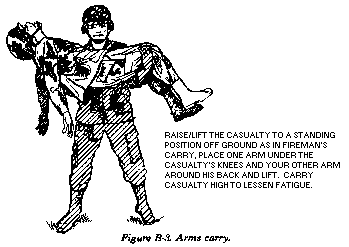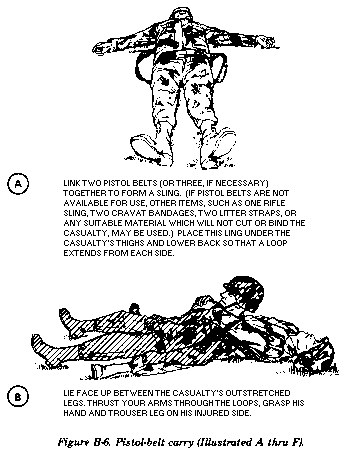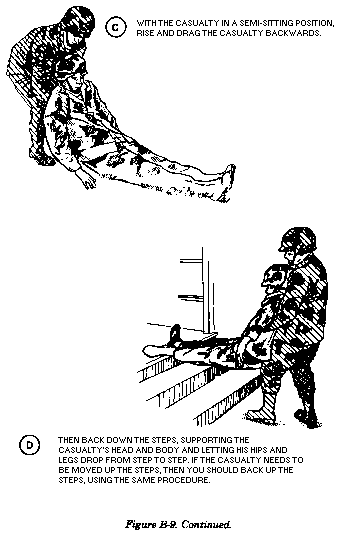First Aid for Soldiers FM 21-11
FM 21-11 First Aid for Soldiers: Appendix B
Rescue and Transportation Procedures
Headquarters, Department of the Army, Washington, D.C., October 27, 1988
B-1. General
A basic principle of first aid is to treat the casualty before moving him. However,
adverse situations or conditions may jeopardize the lives of both the rescuer and the
casualty if this is done. It may be necessary first to rescue the
casualty before first aid can be effectively or safely given. The life and/or the
well-being of the casualty will depend as much upon the manner in which he is rescued
and transported as it will upon the treatment he receives. Rescue actions must be
done quickly and safely. Careless or rough handling of the casualty during rescue
operations can aggravate his injuries and possibly cause death.
B-2. Principles of Rescue Operations
a. When faced with the necessity of rescuing a casualty who is threatened by
hostile action, fire, water, or any other immediate hazard, DO NOT take action without
first determining the extent of the hazard and your ability to handle the situation. DO
NOT become a casualty.
b. The rescuer must evaluate the situation and analyze the factors involved.
This evaluation involves three major steps:
B-3. Task (Rescue) Identification
First determine if a rescue attempt is actually needed. It is a waste of time,
equipment, and personnel to rescue someone not in need of rescuing. It is also a waste to
look for someone who is not lost or needlessly risk the lives of the rescuer(s). In
planning a rescue, attempt to obtain the following information:
-
Who, what, where, when, why, and how the situation happened?
-
How many casualties are involved and the nature of their injuries?
-
What is the tactical situation?
-
What are the terrain features and the location of the casualties?
-
Will there be adequate assistance available to aid in the rescue/evacuation?
-
Can treatment be provided at the scene, will the casualties require movement to a safer
location?
-
What equipment will be required for the rescue operation?
-
Will decon procedures and equipment be required for casualties, rescue personnel and
rescue equipment?
B-4. Circumstances of the Rescue
a. After identifying the job (task) required, you must relate to the
circumstances under which you must work. Do you need additional people, security, medical,
or special rescue equipment? Are there circumstances such as mountain rescue or aircraft
accidents that may require specialized skills? What is the weather like? Is the terrain
hazardous? How much time is available?
b. The time element will sometimes cause a rescuer to compromise planning
stages and/or treatment which can be given. A realistic estimate of time
available must be made as quickly as possible to determine action time remaining. The
key elements are the casualty's condition and the environment.
c. Mass casualties are to be expected on the modern battlefield. All problems
or complexities of rescue are now multiplied by the number of casualties encountered. In
this case, time becomes the critical element.
B-5. Plan of Action
a. The casualty's ability to endure is of primary importance in estimating the
time available. Age and physical condition will differ from casualty to casualty.
Therefore, to determine the time available, you will have to consider--
b. In respect to terrain, you must consider altitude and visibility. In some
cases, the casualty may be of assistance because he knows more about the particular
terrain or situation than you do. Maximum use of secure/reliable trails or roads is
essential.
c. When taking weather into account, ensure that blankets and/or rain gear are
available. Even a mild rain can complicate a normally simple rescue. In high altitudes
and/or extreme cold and gusting winds, the time available is critically shortened.
d. High altitudes and gusting winds minimize the ability of fixed-wing or
rotary wing aircraft to assist in operations. Rotary wing aircraft may be available to
remove casualties from cliffs or inaccessible sites. These same aircraft can also
transport the casualties to a medical treatment facility in a comparatively short time.
Aircraft, though vital elements of search, rescue or evacuation, cannot be used in all
situations. For this reason, do not rely entirely on their presence. Reliance on aircraft
or specialized equipment is a poor substitute for careful planning.
B-6. Mass Casualties
In situations where there are multiple casualties, an orderly rescue may involve some
additional planning. To facilitate a mass casualty rescue or evacuation, recognize
separate stages.
-
First Stage. Remove those personnel who are not trapped among debris or who can
be evacuated easily.
-
Second Stage. Remove those personnel who may be trapped by debris but require
only the equipment on hand and a minimum amount of time.
-
Third Stage. Remove the remaining personnel who are trapped in extremely
difficult or time-consuming situations, such as under large amounts of debris or behind
walls.
-
Fourth Stage. Remove the dead.
B-7. Proper Handling of Casualties
a. You may have saved the casualty's life through the application of
appropriate first aid measures. However, his life can be lost through rough handling or
careless transportation procedures. Before you attempt to move the casualty--
-
Evaluate the type and extent of his injury.
-
Ensure that dressings over wounds are adequately reinforced.
-
Ensure that fractured bones are properly immobilized and supported to prevent them from
cutting through muscle, blood vessels, and skin. Based upon your evaluation of the type
and extent of the casualty's injury and your knowledge of the various manual carries, you
must select the best possible method of manual transportation. If the casualty is
conscious, tell him how he is to be transported. This will help allay his fear of movement
and gain his cooperation and confidence.
b. Buddy aid for chemical agent casualties includes those actions required to
prevent an incapacitated casualty from receiving additional injury from the effects of
chemical hazards. If a casualty is physically unable to decontaminate himself or
administer the proper chemical agent antidote, the casualty's buddy assists him and
assumes responsibility for his care. Buddy aid includes--
-
Administering the proper chemical agent antidote.
-
Decontaminating the incapacitated casualty's exposed skin.
-
Ensuring that his protective ensemble remains correctly emplaced.
-
Maintaining respiration.
-
Controlling bleeding.
-
Providing other standard first aid measures.
-
Transporting the casualty out of the contaminated area.
B-8. Transportation of Casualties
a. Transportation of the sick and wounded is the responsibility of medical
personnel who have been provided special training and equipment. Therefore, unless a good
reason for you to transport a casualty arises, wait for some means of medical evacuation
to be provided. When the situation is urgent and you are unable to obtain medical
assistance or know that no medical evacuation facilities are available, you will have to
transport the casualty. For this reason, you must know how to transport him without
increasing the seriousness of his condition.
b. Transporting a casualty by litter (FM 8-35) is safer and more comfortable
for him than by manual means; it is also easier for you. Manual transportation, however,
may be the only feasible method because of the terrain or the combat situation; or it may
be necessary to save a life. In these situations, the casualty should be transferred to a
litter as soon as one can be made available or improvised.
B-9. Manual Carries
(081-831-1040 and 081-831-1041)
|
Casualties carried by manual means must be carefully and correctly handled, otherwise
their injuries may become more serious or possibly fatal. Situation permitting, evacuation
or transport of a casualty should be organized and unhurried. Each movement should be
performed as deliberately and gently as possible. Casualties should not be moved before
the type and extent of injuries are evaluated and the required emergency medical treatment
is given. The exception to this occurs when the situation dictates immediate movement for
safety purposes (for example, it may be necessary to remove a casualty
from a burning vehicle); that is, the situation dictates that the urgency of casualty
movement outweighs the need to administer emergency medical treatment. Manual carries are
tiring for the bearer(s) and involve the risk of increasing the severity of the casualty's
injury. In some instances, however, they are essential to save the casualty's life.
Although manual carries are accomplished by one or two bearers, the two-man carries are
used whenever possible. They provide more comfort to the casualty, are less likely to
aggravate his injuries, and are also less tiring for the bearers, thus enabling them to
carry him farther. The distance a casualty can be carried depends on many factors, such
as--
-
Strength and endurance of the bearer(s).
-
Weight of the casualty.
-
Nature of the casualty's injury.
-
Obstacles encountered during transport.
a. One-man Carries (081-831-1040).
(1) Fireman's carry (081-831-1040). The fireman's carry (Figure
B-1) is one of the easiest ways for one person to carry another. After an unconscious
or disabled casualty has been properly positioned, he is raised from the ground. An
alternate method for raising him from the ground is illustrated (Figure
B-1 I). However, it should be used only when the bearer believes it to be safer for
the casualty because of the location of his wounds. When the alternate method is used,
take care to prevent the casualty's head from snapping back and causing a neck injury. The
steps for raising a casualty from the ground for the fireman's carry are also used in
other one-man carries.
|
Figure B-1 Fireman carry.
(2) Support carry (081-831-1040). In the support carry (Figure
B-2), the casualty must be able to walk or at least hop on one leg, using the bearer
as a crutch. This carry can be used to assist him as far as he is able to walk or hop.

(3) Arms carry (081-831-1040). The arms carry is used when the casualty is
unable to walk. This carry (Figure B-3) is useful when carrying
a casualty for a short distance and when placing him on a litter.

(4) Saddleback carry (081-831-1040). Only a conscious casualty can be
transported by the saddleback carry (Figure B-4), because he
must be able to hold onto the bearer's neck.

(5) Pack-strap carry (081-831-1040). This carry is used when only a moderate
distance will be traveled. In this carry (Figure B-5), the
casualty's weight rests high on the bearer's back. To eliminate the possibility of injury
to the casualty's arms, the bearer must hold the casualty's arms in a palms-down position.

(6) Pistol-belt carry (081-831-1040). The pistol-belt carry (Figure B-6) is the best one-man carry when the distance to be traveled
is long. The casualty is securely supported by a belt upon the shoulders of the bearer.
The hands of both the bearer and the casualty are left free for carrying a weapon or
equipment, climbing banks, or surmounting obstacles. With his hands free and the casualty
secured in place, the bearer is also able to creep through shrubs and under low hanging
branches.



(7) Pistol-belt drag (081-831-1040). The pistol-belt drag (Figure B-7) and other drags are generally used for short
distances. In this drag the casualty is on his back. The pistol-belt drag is useful in
combat. The bearer and the casualty can remain closer to the ground in this drag than in
any other.

Adjust/Extend Two Pistol Belts (Or Three, If Necessary) Or Similar Objects To Their
Full Length And Join Them Together To Make One Loop. Roll The Casualty Onto His Back. Pass
The Loop Over The Casualty's Head And Position It Across His Chest And Under His Armpits;
Then Cross The Remaining Portion Of The Loop, Thus Forming A Figure Eight. Keep Tension On
The Belts So They Do Not Become Unhooked. Lie On Your Side Facing The Casualty, Resting On
Your Elbow. Slip The Loop Over Your Arm And Shoulder That Your Leaning On And Turn
Away
From The Casualty Onto Your Abdomen, Thus Enabling You To Drag The Casualty As You Crawl.
(8) Neck drag (081-831-1040). The neck drag (Figure B-8)
is useful in combat because the bearer can transport the casualty when he creeps behind a
low wall or shrubbery, under a vehicle, or through a culvert. This drag is used only if
the casualty does not have a broken/ fractured arm. In this drag the casualty is on his
back. If the casualty is unconscious, protect his head from the ground.

(9) Cradle drop drag (081-831-1040). The cradle drop drag (Figure
B-9) is effective in moving a casualty up or down steps. In this drag the casualty is
lying down.


|
b. Two-man Carries (081-831-1041).
(1) Two-man support carry (081-831-1041). The two-man support carry (Figure B-10) can be used in transporting both conscious or
unconscious casualties. If the casualty is taller than the bearers it may be necessary for
the bearers to lift the casualty's legs and let them rest on their forearms.
|
(2) Two-man arms carry (081-831-1041). The two-man arms carry (Figure B-11) is useful in carrying a casualty for a moderate
distance. It is also useful for placing him on a litter. To lessen fatigue, the bearers
should carry him high and as close to their chests as possible. In extreme emergencies
when there is no time to obtain a board, this manual carry is the safest one for
transporting a casualty with a back/neck injury. Use two additional bearers to keep his
head and legs in alignment with his body.
|
(3) Two-man fore-and-aft carry (081-831-1041). The fore-and-aft carry (Figure B-12) is a most useful two-man carry for transporting
a casualty for a long distance. The taller of the two bearers should position himself at
the casualty's head. By altering this carry so that both bearers face the casualty, it is
also useful for placing him on a litter.
|


(4) Two-hand seat carry (081-831-1041). The two-hand seat carry (Figure B-13) is used in carrying a casualty for a short distance
and in placing him on a litter.
|

(5) Four-hand seat carry (081-831-1041). Only a conscious casualty can be
transported with the four-hand seat carry (Figure B-14) because
he must help support himself by placing his arms around the bearers' shoulders. This carry
is especially useful in transporting the casualty with a head or foot injury and is used
when the distance to be traveled is moderate. It is also useful for placing a casualty on
a litter.
|

Two men can support or carry a casualty without equipment for only short distances. By
using available materials to improvise equipment, the casualty can be transported greater
distances by two or more rescuers.
a. There are times when a casualty may have to be moved and a standard litter
is not available. The distance may be too great for manual carries or the casualty may
have an injury, such as a fractured neck, back, hip, or thigh that would be aggravated by
manual transportation. In these situations, litters can be improvised from certain
materials at hand. Improvised litters are emergency measures and must be replaced
by standard litters at the first opportunity to ensure the comfort and safety of the
casualty.
b. Many different types of litters can be improvised, depending upon the
materials available. Satisfactory litters can be made by securing poles inside such items
as blankets, ponchos, shelter halves, tarpaulins, jackets, shirts, sacks, bags, and bed
tickings (fabric covers of mattresses). Poles can be improvised from strong branches, tent
supports, skis, and other like items. Most flat-surface objects of suitable size can also
be used as litters. Such objects include boards, doors, window shutters, benches, ladders,
cots, and poles tied together. If possible, these objects should be padded.
c. If no poles can be obtained, a large item such as a blanket can be rolled
from both sides toward the center. The rolls then can be used to obtain a firm grip when
carrying the casualty. If a poncho is used, make sure the hood is up and under the
casualty and is not dragging on the ground.
d. The important thing to remember is that an improvised litter must be well
constructed to avoid the risk of dropping or further injuring the casualty.
e. Improvised litters may be used when the distance may be too long (far) for
manual carries or the casualty has an injury which may be aggravated by manual
transportation.



f. Any of the appropriate carries may be used to place a casualty on a litter.
These carries are:
WARNING
Unless there is an immediate life-threatening situation (such as fire, explosion), DO
NOT move the casualty with a suspected back or neck injury. Seek medical personnel for
guidance on how to transport.
g. Either two or four soldiers (head/foot) may be used to lift a litter. To
lift the litter, follow the procedure below.
(1) Raise the litter at the same time as the other carriers/bearers.
(2) Keep the casualty as level as possible.
NOTE
Use caution when transporting on a sloping incline/hill.
|




















